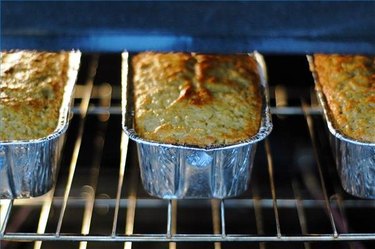
Once found primarily in commercial kitchens, the convection oven has become an essential appliance for many home cooks. A gas or electric oven is perfectly adequate for baking, roasting or broiling your favorite dishes, while a convection oven shortens cooking times by approximately 25 percent – a plus for a busy household. Whether you select a countertop model, microwave/convection combo, conventional electric stove with a convection option or a hybrid combination of gas burners and electric combination conventional/convection oven, there's a few important details that will ensure your roast, casseroles, cakes and cookies turn out just right.
How Convection Ovens Work
Video of the Day
A convection oven is basically an electric oven with a fan and exhaust system that circulates the hot air to ensure an even temperature throughout the oven with no cold or hot spots. It also reduces the moisture inside the oven, which helps produce a crispy brown exterior. If you're a fan of British baking shows, you may wonder when the host mentions an oven temperature "with fan." The quick answer is that they're using the convection setting.
Video of the Day
Depending on the manufacturer and the type of stove you've selected, there are a few things to double-check in the manual. Some ovens have a choice of conventional or convection settings, but if you set the oven at the convection setting, you can't just push a button to change the setting. You have to turn off the oven completely and then reset it for conventional baking. Also check the manual to see if your oven automatically adjusts the temperature when you choose the convection setting or if you have to manually calculate the temperature difference.
Temperature Conversion for a Convection Oven
Because the fan in a convection oven moves the heat around, it speeds up the cooking process, and you'll have to adjust the temperature and cooking time. Unless your cookbook features convection oven recipes, reduce the temperature by 25 to 50 degrees Fahrenheit and shorten the cook time by 25 percent when using the convection option. Monitor the oven closely to ensure that your food isn't cooking too quickly, which can affect baked goods, like cakes, custards and meringues.
Convection Oven Cooking
Convection ovens heat the outside of foods quickly, but the interior is slower to cook because it doesn't have direct contact with the hot air circulating through the space. This is ideal for roasting prime rib, leg of lamb and other large cuts of meat that are medium rare with a nicely browned exterior. However, a whole chicken or turkey needs the interior cooked to 165 degrees Fahrenheit. With poultry, it's best to lower the temperature but leave the cooking time the same and start checking the temperature with a meat thermometer at approximately two-thirds to three-fourths through the cooking time.
When baking cookies or cakes, you may have to lower the temperature by 50 degrees to slow the cooking process or use the conventional oven option. Baked items that start with a liquid batter tend to cook too quickly on the outside, leaving the interior uncooked, and cheesecakes and custards need a moist environment. Cakes are better cooked in a conventional oven because the higher temperature and quick baking results in a dome top. The fan can affect the appearance as well, leaving ripples in the top of your banana bread.